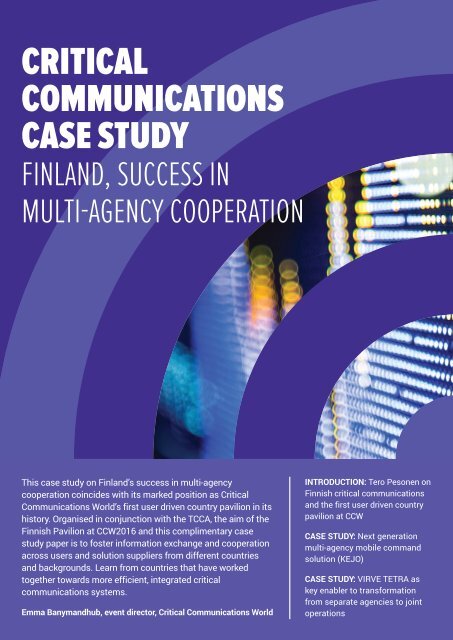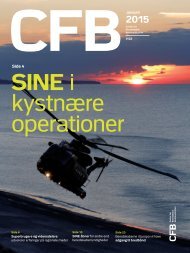CRITICAL COMMUNICATIONS CASE STUDY
6015BqJhc
6015BqJhc
Create successful ePaper yourself
Turn your PDF publications into a flip-book with our unique Google optimized e-Paper software.
<strong>CRITICAL</strong><br />
<strong>COMMUNICATIONS</strong><br />
<strong>CASE</strong> <strong>STUDY</strong><br />
FINLAND, SUCCESS IN<br />
MULTI-AGENCY COOPERATION<br />
This case study on Finland’s success in multi-agency<br />
cooperation coincides with its marked position as Critical<br />
Communications World’s first user driven country pavilion in its<br />
history. Organised in conjunction with the TCCA, the aim of the<br />
Finnish Pavilion at CCW2016 and this complimentary case<br />
study paper is to foster information exchange and cooperation<br />
across users and solution suppliers from different countries<br />
and backgrounds. Learn from countries that have worked<br />
together towards more efficient, integrated critical<br />
communications systems.<br />
Emma Banymandhub, event director, Critical Communications World<br />
INTRODUCTION: Tero Pesonen on<br />
Finnish critical communications<br />
and the first user driven country<br />
pavilion at CCW<br />
<strong>CASE</strong> <strong>STUDY</strong>: Next generation<br />
multi-agency mobile command<br />
solution (KEJO)<br />
<strong>CASE</strong> <strong>STUDY</strong>: VIRVE TETRA as<br />
key enabler to transformation<br />
from separate agencies to joint<br />
operations
INTRODUCTION<br />
FOCUS ON FINLAND AND THE FIRST USER<br />
DRIVEN COUNTRY PAVILION AT CCW<br />
Tero Pesonen, Critical Communications<br />
Broadband Group chairman, TETRA and<br />
Critical Communications Association<br />
“<br />
The world we live in is<br />
quite different - internet,<br />
mobility and globalisation<br />
are pushing operational<br />
needs.<br />
In the 90s, Finland was one of the first<br />
countries to introduce a nationwide shared<br />
TETRA network for all governmental<br />
authorities. Back then a number of user<br />
representatives such as Janne Koivukoski,<br />
Heikki Riippa and Matti Sivula to name just a<br />
few contributed strongly to the formation of<br />
TETRA standard and its capabilities to<br />
address the needs of cooperative public<br />
safety operations. Since then, field operation<br />
has continuously been developing,<br />
embracing further user groups, addressing<br />
new needs and shaking previous structures.<br />
COOPERATION IS KEY<br />
The resourcing in terms of financing as well<br />
as in manpower are limited and Finland<br />
cannot alone set course of development,<br />
which has led to the Finnish critical<br />
communications community seeking for<br />
cooperation possibilities, as well as finding<br />
ways to enhance and support mutual trust<br />
between stakeholders.<br />
Three great examples of this cooperation are:<br />
1. The Common Emergency Response Centre<br />
(ERC) provides a service to all agencies<br />
nationwide. From an administration and<br />
technical point of view, it is one entity with<br />
six physical locations.<br />
2. Police, customs and the border guard share<br />
same rights and obligations. So, they can be<br />
assigned interchangeably to missions<br />
providing great flexibility. This is particularly<br />
effective in the countryside, where units<br />
might be far apart.<br />
3. Utilities and public transport are invited<br />
to the same shared critical communications<br />
network. Ensuring energy supply is critical<br />
in modern society and the needs of railway<br />
communication can be fulfilled together<br />
with public safety as long as sufficient<br />
attention is given into details.<br />
MANAGING EXPECTATIONS<br />
Now, there is strong recognition that the world<br />
we live in is quite different – internet, mobility<br />
and globalisation are pushing operational<br />
needs. The post Google-born generation is also<br />
graduating to public safety professions with<br />
new expectations as we speak. This new era<br />
calls for re-inventing critical communication<br />
This new era calls for re-inventing critical<br />
communication. Now is the time to put joint<br />
effort in it. This is why Critical<br />
Communications Finland is now advocating<br />
seizing the moment for common good.<br />
SPOTLIGHT ON FINLAND<br />
At the Finnish Pavilion, Finnish authorities<br />
and the national public safety operator VIRVE<br />
will be sharing how Finnish safety and<br />
security agencies, social stakeholders and<br />
solution providers have made progress<br />
through co-operation and collaboration. A<br />
visitor will have a chance to learn first-hand<br />
how far Finnish critical communication<br />
users have come, as they open their way of<br />
working, sharing cooperation methods and<br />
how they addressed common challenges. An<br />
emergency services joint field commanding<br />
unit will be part of the Finnish Pavilion,<br />
demonstrating the technical solution in use.<br />
Cyber security has also been considered - from<br />
the state security smart phone usage down to<br />
the last fire fighter. The ability to build<br />
independent back-up transmission for base<br />
stations will also be addressed. But it is not only<br />
about the technology. It is also about finding<br />
solutions of how to plan and test field operations<br />
and train end users to harness the benefits.
LEARNING FROM EACH OTHER<br />
The target of the Finnish Pavilion is to trigger<br />
a dialogue with visitors for mutual learning in<br />
order to foster practical and tangible<br />
discussion. To enable this, fourteen leading<br />
providers will showcase their critical<br />
communications solutions that together are<br />
enabling the end-to-end field operations.<br />
There are great things happening all<br />
around the world in our industry at the<br />
moment, including the remarkable crossborder<br />
work between Norway and Sweden.<br />
The exceptional thing in Finland is the<br />
critical communications ecosystem that<br />
everyday tries to address challenges too<br />
large for any single participant, but<br />
achieves this due to a vast collection of<br />
experience and competence. It has its<br />
founding in the academia, it is humble<br />
enough to listen, sufficiently patient to look<br />
beyond the horizon, while being practical to<br />
deliver needed solutions today.<br />
But, the journey to deeper co-operation, better<br />
performance and greater innovation continues<br />
“<br />
The target of the Finnish<br />
Pavilion is to trigger a<br />
dialogue with visitors for<br />
mutual learning in order<br />
to foster practical and<br />
tangible discussion.
<strong>CASE</strong> <strong>STUDY</strong><br />
NEXT GENERATION MULTI-AGENCY<br />
MOBILE COMMAND SOLUTION (KEJO)<br />
Markus Asikainen, project director,<br />
Finnish Police Board<br />
“<br />
By enabling more work<br />
processes to be executed<br />
in the field, authorities<br />
are able to focus on their<br />
core functions instead of<br />
travelling to the back<br />
office for daily routines.<br />
KEJO is an ongoing unique joint project for<br />
the police, rescue services, social- and health<br />
services, border guard, defence forces and<br />
customs. The new KEJO-system will replace<br />
current systems and give the next generation<br />
a platform for presenting, capturing and<br />
sharing mission critical information.<br />
ATTACKING THE PROBLEM<br />
With this project we are trying to tackle the fact<br />
that structural changes in public safety<br />
organisations and decreasing resources put<br />
pressure to be more cost-effective. At present<br />
there are different ICT-solutions used on the<br />
field environment - causing parallel costs and<br />
technical boundaries for information sharing<br />
and for integrated workflows among the actors.<br />
We know that there is and will be more work to<br />
do in the future and there is an uprising trend<br />
of demand for public safety services.<br />
PROJECTED OUTCOMES<br />
The top-level scope is to execute the<br />
development project cost-effectively and<br />
produce added value for the agencies<br />
involved. The outcome will be<br />
implementation of new common field<br />
operations information systems and new<br />
harmonized operational models that help<br />
authorities to work more efficiently, safely<br />
and collaborate on the field. Project outcomes<br />
set the situational awareness to the next<br />
level, especially when talking about the<br />
mission critical data and field leading.<br />
The Finnish 112-renewal (which started in<br />
2007) was one of the main drivers for the<br />
KEJO-project. In Finland there is one<br />
nationwide governmental and centralised<br />
112-organisation for multi-agency ERCs (6<br />
networked emergency response centres).<br />
Project targets are effective co-operation and<br />
collaboration between the agencies and<br />
better shared situation awareness.<br />
Also implementation of new work processes<br />
in the field conditions ("mobilisation") and<br />
("getting out from the office") are recognised<br />
targets. By enabling more work processes to<br />
be executed in the field, authorities are able<br />
to focus on their core functions instead of<br />
travelling to the back office for daily routines.<br />
We hope that this improvement and<br />
rationalisation will result in shorter<br />
turnaround times.<br />
The main benefits are going to be costefficiency,<br />
a larger portfolio of better quality<br />
public safety services, better work safety,<br />
enhanced situational awareness and<br />
collaboration, better capability to manage<br />
joint operations, better preparedness for<br />
crisis, in addition to improved and more<br />
focused resource planning.<br />
BUMPS ALONG THE WAY<br />
This project covers multiple stakeholders and<br />
we have to balance between different kinds<br />
of interests; despite of the idea of operational<br />
harmonization, there are still varying<br />
organisational and operational cultures - this<br />
leads to different kinds of operational needs<br />
that has to be taken into account.<br />
Because of this, we have to maintain<br />
common trust and shared vision from the<br />
very beginning to the far end of the project.<br />
To ensure commitment we need continuous<br />
negotiation and open discussion about the<br />
roadmap. When building one common<br />
system for all agencies, it is not always so<br />
easy to achieve needed compromises when<br />
defining requirements for the system and<br />
their priorities.
It is also fair to say, that this kind of multiagency<br />
project is forced to carry a weight of<br />
being the pioneer with its wide meaning; many<br />
developmental acts are done for the very first<br />
time. This means in practice that we have to<br />
continuously be able to create innovative new<br />
ways for solving different kinds of problems<br />
and be agile enough for making rapid<br />
decisions. Because of this project stakeholders<br />
are coming from the different sectors<br />
(governmental, municipal and private service<br />
providers), the governance model and<br />
common planning are faced challenges.<br />
execute joint operations, where the citizen is<br />
at the centre of the service; a first responder<br />
in the future will be any nearest appropriate<br />
resource, despite of the agency or "colour of<br />
the vehicle".<br />
The use of mobile-services grows and with<br />
this trend also comes the need for new ICT<br />
platforms and solutions that support daily<br />
routines and are easy to use on the field. The<br />
increasing need for mobilisation demands<br />
better network capacities and dedicated<br />
bandwidths.<br />
“<br />
We have to maintain<br />
common trust and shared<br />
vision from the very<br />
beginning to the far end<br />
of the project.<br />
MOVING FORWARD<br />
The key word will still be "doing things<br />
together" - also integrated work processes<br />
among the agencies will become more<br />
general. In Finland at least, agencies will<br />
Integration will mean in the future both<br />
technical and operational integration.<br />
Regulative norms such as legislation will be<br />
improved to a direction where mission<br />
critical information sharing and use of open<br />
data becomes more dynamic.
<strong>CASE</strong> <strong>STUDY</strong><br />
VIRVE TETRA AS KEY ENABLER TO<br />
TRANSFORMATION FROM SEPARATE<br />
AGENCIES TO JOINT OPERATIONS<br />
Janne Koivukoski, deputy director<br />
general, Ministry of the Interior Rescue<br />
Services for Finland<br />
“<br />
Our ambition was to<br />
achieve better radio<br />
communication systems<br />
using the same budget we<br />
already had.<br />
Without going back in the history to tell the<br />
whole story of our Finnish TETRA-project, we<br />
had big troubles trying to solve all our<br />
communication problems at the beginning of<br />
90s. At the same time there was also a need<br />
to get better integration between different<br />
emergency call authorities. There were<br />
parallel projects to solve both problems.<br />
Now we have been running the TETRA radio<br />
network over 18 years and it has been<br />
countrywide since 2002. With that TETRA<br />
radio network and our emergency response<br />
centers we have saved a lot of money and<br />
lives. I cannot see any other project which<br />
has been so beneficial to our safety and<br />
security in Finland.<br />
A NEED FOR INTERGRATION<br />
To get better co-operation and faster<br />
response time between units which were<br />
working on the field there needed to be better<br />
integration between different emergency call<br />
centres too.<br />
The first problem was to find a solution to<br />
getting new radio communication systems to<br />
replace earlier analogue radio systems in<br />
Finland. Our ambition was to achieve better<br />
radio communication systems using the<br />
same budget we already had. The second<br />
problem was a need to build a totally<br />
integrated emergency response system to<br />
cater for all authorities.<br />
During the planning phase, we already had a<br />
pilot centre where we recognised that we<br />
could achieve the best quality and fastest<br />
operation by using the same operator for<br />
different authorities. We also developed a<br />
unique training programme for the<br />
emergency centre operators.<br />
OVERCOMING CHALLENGES<br />
The biggest challenge at the beginning was<br />
to get common understanding of the target.<br />
Every authority thought that they had their<br />
own needs and specifications which were<br />
impossible to fit together. It took several years<br />
to reach the consensus and some people<br />
needed to retire during the process to achieve<br />
it. Of course, limited financial resources were<br />
also a big challenge for us. But there we could<br />
convince political leaders at that time so well<br />
that we got the money. The third challenge<br />
for us was that there was no standard<br />
solution for us and we were the first in the<br />
world to do this.<br />
A SUITE OF BENEFITS<br />
The benefits for us were that we could, as<br />
forerunners, lead the path to success and<br />
organise the systems suit our needs.<br />
Additional benefits were those we had set for<br />
ourselves: a new digital shared radio network<br />
for all authorities which has enabled our<br />
integrated emergency response system and<br />
enhanced our communications ability.<br />
If we had built several radio networks the<br />
costs would have been much higher than our<br />
solution to use the same network for all. Also<br />
to get the same benefits which we can<br />
achieve via integrated network (common<br />
talking groups), we would have needed to<br />
have more investment.<br />
If we take the police as an example user<br />
group, the new system was cheaper to use as<br />
their earlier networks were there. For some<br />
local users the user fees were more<br />
expensive than the old ones, but they got new<br />
co-operation possibilities with other<br />
authorities.
Maybe the best examples of how the<br />
integrated network has helped to save<br />
lives are the complex multi hazard<br />
accidents. One example of that kind<br />
accident was a sudden, severe weather<br />
traffic accident near Helsinki where there<br />
were several hundred vehicles involved<br />
and only three deaths.<br />
Through one call, our system offers a<br />
complete evaluation of the accident, direct<br />
alerting to appropriate units and also<br />
information support to various authorities on<br />
the field, in addition to informing the caller.<br />
EUROPEAN CONSENSUS<br />
I can see that there is a need to find a<br />
standard solution to critical broadband data<br />
communication in the near future. The<br />
critical voice will stay for several years in<br />
TETRA systems because big financial<br />
investments have been made to support it in<br />
its mature phase and it will continue to serve<br />
users for many years to come.<br />
The biggest work is to see a common target<br />
for all European actors and find consensus<br />
in that.<br />
“<br />
It took several years to<br />
reach the consensus and<br />
some people needed to<br />
retire during the process<br />
to achieve it.
The Critical Communications Finland Pavilion is free to attend and is<br />
located at stand C.23 at the main entrance to the exhibition hall.<br />
Critical Communications Finland will host Finnish authorities and the<br />
national public safety operator VIRVE, who will share their practical<br />
experience on how national, regional, local operations and incidents are<br />
successfully taken care of. Finnish technology providers will also be<br />
showcasing their solutions and will share their experience of how these<br />
solutions have been implemented and used.<br />
The Finnish Pavilion opening will take place at 16:30 on May 31,<br />
inaugurated by Mr. Esko Koskinen, director general for Rescue Services at<br />
the Ministry of the Interior Department.<br />
Register today to ensure you do not miss out on the opportunity to visit<br />
one of the leading global projects: http://bit.ly/1R8oy0y<br />
ENTRANCE<br />
Follow us on Twitter: @CritComms_World<br />
Join the LinkedIn group: https://www.linkedin.com/groups/1881918<br />
Get involved using our hashtag #CCW2016




